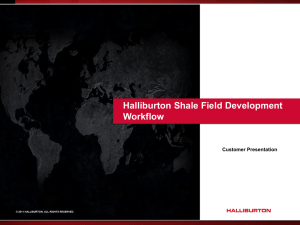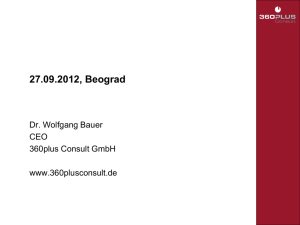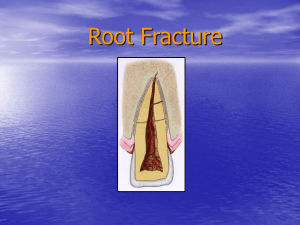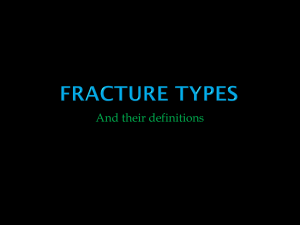Flow Modeling
advertisement
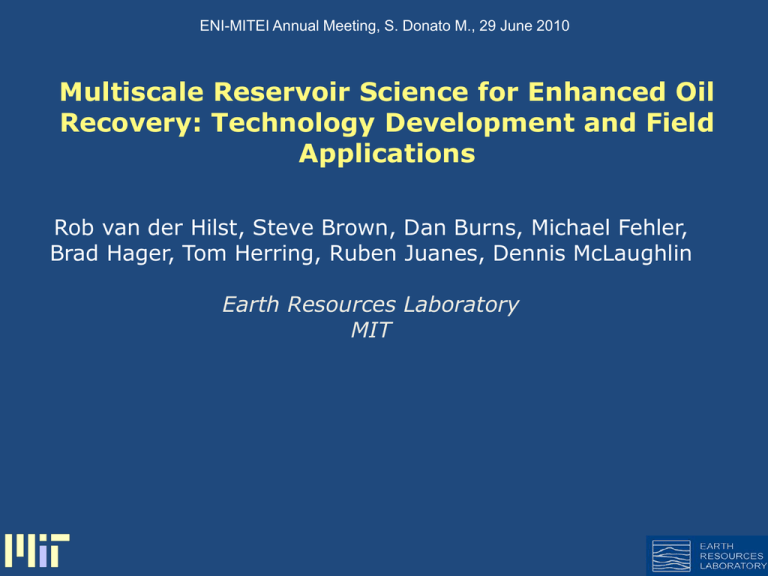
ENI-MITEI Annual Meeting, S. Donato M., 29 June 2010 Multiscale Reservoir Science for Enhanced Oil Recovery: Technology Development and Field Applications Rob van der Hilst, Steve Brown, Dan Burns, Michael Fehler, Brad Hager, Tom Herring, Ruben Juanes, Dennis McLaughlin Earth Resources Laboratory MIT Overall Motivation: To meet demand: New fields (e.g., deep off-shore, near/beneath complex structures, arctic region) Enhanced Oil Recovery (EOR) from existing fields (global average < 40%) Unconventional oil/gas (heavy oils, tar sands, tight gas reservoirs, hydrates) Challenge: Increase production from reservoirs that are complex and strongly heterogeneous (both for new and existing fields) Reservoir management: Predict reservoir performance to enable optimal operation: – Maximize reservoir sweep – Best well placement and completion design Integration of geophysical description with reservoir models more reliable prediction of performance For example: fractured reservoirs deformation during passage of a compressional wave Carbonate cliffs geology/geophysics ↔ flow modeling ↔ enhanced production ? Oil Production Oil Seismic Data Willis et al (2006) Water Injection Water Front What do we want to know? • Where are the fractures? • What are the fracture orientations? • What are the fluid-flow properties of fractures (that is, how do fluids flow through them)? Approach: • Joint analysis of geophysical response (e.g., scattering from fractures and heterogeneity, deformation) and flow Using Geophysics to Constrain Flow Mode Geophysics-constrained reservoir description Geophysics-constrained permeability model Kfrac Reservoir description from geophysics Response (e.g. well rate) Qwell model Model updated with new data data time INTEGRATED RESERVOIR SCIENCE 1: Reservoir Structure and Response – – – – Fracture Characterization (e.g., seismics) Flow Simulation Data assimilation & real-time control Quantitative integration INTEGRATED RESERVOIR SCIENCE 1: Reservoir Structure and Response 2: Reservoir Evolution and Performance – Surface deformation (GPS & InSAR) – Coupled geomechanical/reservoir modeling INTEGRATED RESERVOIR SCIENCE 1: Reservoir Structure and Response 2: Reservoir Evolution and Performance 3: Application of New Concepts (Field Case Study) Integration of Geophysics & Reservoir performance modeling Different Levels of Integration Data Model • Surface deformation • Production data - tiltmeters •Surface seismic • Well logs • Analogue reservoirs •Fracture characterization - InSAR, GPS • Wellbore breakouts • 3D seismic • Induced seismicity Flow models Geophysical interpretation Geomechanical modeling coupled Clearly insufficient CTRW-RTT joint inversion methodology Main outcomes: 3-way data assimilation methodology • Better forecasts • Optimal production to maximize recovery while controlling subsidence Different Levels of Integration Data Model • Surface deformation • Production data - tiltmeters •Surface seismic • Well logs • Analogue reservoirs •Fracture characterization - InSAR, GPS • Wellbore breakouts • 3D seismic • Induced seismicity Flow models Geophysical Geomechanical interpretation coupled modeling coupled Main outcomes: 3-way data assimilation methodology • Better forecasts • Optimal production to maximize recovery while controlling subsidence Different Levels of Integration Data Model • Surface deformation • Production data - tiltmeters •Surface seismic • Well logs • Analogue reservoirs •Fracture characterization - InSAR, GPS • Wellbore breakouts • 3D seismic • Induced seismicity Flow models Geophysical Geomechanical interpretation coupled modeling coupled CTRW-RTT joint inversion methodology 3-way data assimilation methodology Main outcomes: 3-way data assimilation methodology • Better forecasts • Optimal production to maximize recovery while controlling subsidence Different Levels of Integration Data Model • Surface deformation • Production data - tiltmeters •Surface seismic • Well logs • Analogue reservoirs •Fracture characterization - InSAR, GPS • Wellbore breakouts • 3D seismic • Induced seismicity Flow models Geophysical Geomechanical interpretation coupled modeling coupled CTRW-RTT joint inversion methodology 3-way data assimilation methodology Main outcomes: • Better forecasts • Optimal production to maximize recovery while controlling subsidence Numerical and Laboratory Modeling of Scattering from Fractures • Understand seismic response of fractures and fracture systems – Develop new field-data analysis approaches – Platform/data for testing & evaluation of new methods • Develop models to test relationships between fracture compliance, roughness, permeability, and seismic scattering Numerical and Laboratory Modeling of Scattering from Fractures • Seismic response – Numerical • • • • • Single and multiple fractures 2D and 3D P-to-P and P-to-S scattering Finite difference; semi-analytical; boundary element Static models to estimate compliance – Experimental • Multiple fracture model • Incorporate flowing fractures wave length fracture seismic response homogeneous anisotropy zone (1) (2) (3) Focus Area Linear-slip Fracture Model (Schoenberg, 1980) Fracture Compliance fracture u u2 u1 Z T u1 u2 displacement compliance traction length/stress [m/Pa] “zero” thickness Numerical Model 1 single fracture (NB we can do this also in 3D) P-wave P scattered waves 2D P-to-P Fracture Response Function (FRF) Numerical Model 2 Numerical Model Multiple Fractures Multiple (parallel) Fractures) Fracture Spacing 50 m Aperture 5 m Fracture Zone 50 m thick Ra psNMO11 fracture10 Tr 900 az=0 800 9 az=10 700 8 az=20 Transverse component 0 60 amplitude shows strong az=30 7 near 45 degrees 500 6 az=40 400 5 az=50 300 4 az=60 200 approach 3 az=70 New to 100 scattering in analyzing 2 az=80 field data? 00 1 az=90 0 2 0.5 Time (sec) 1 Vz 11 11 900 10 az=0 800 9 az=10 900 10 az=0 800 9 az=10 700 8 az=20 600 7 az=30 700 8 az=20 600 7 az=30 500 6 az=40 400 5 az=50 500 6 az=40 400 5 az=50 300 4 az=60 200 3 az=70 300 4 az=60 200 3 az=70 100 2 az=80 100 2 az=80 00 1 az=90 00 1 az=90 0 0.5 Time (sec) 1 0 0.5 Time (sec) 1 Laboratory Experiments: Current Status 30 cm • Seismic acquisition geometries – Iso-Offset acquisition at different azimuths – Common source gathers at different azimuths – CDP gathers at different azimuths • Comparison with numerical models • Move towards joint seismic-flow experiments Laboratory Experiments: Acquisition Geometry 900 100 00 Offset = 6 cm P Wave Source P, S Receiver PP 2nd interface 90 80 70 60 50 40 30 Transverse component shows strong amplitude near 45 degrees (similar to numerical result) 20 10 0 PP Fracture Tip P-S Converted SS Fracture Tip Conclusions Modeling • The amplitude of scattered-waves scales with compliance (Z) • Radiation patterns depend mostly on ratio of normal to tangential compliance (ZN/ZT) • On the transverse component, P-S Converted wave shows maximum amplitude at about 40-500 possible new orientation attribute • On the inline component, P-S Converted wave shows systematic increase in amplitude towards 900 (not shown) possible new orientation attribute • Stacking enhances signal in a direction parallel to fracture orientation (consistent with Scattering Index - Willis et al., 2006) The insight thus obtained can be used to infer fracture compliance from seismic field data Compliance (e.g., from seismics) Permeability – – – Elastic compliance is a key parameter influencing seismic scattering in fractured rocks. We want to know more about compliance values, scaling, and relation to permeability We are conducting numerical studies based on realistic fracture roughness statistics Fehler, Burns, Brown Compliance (e.g., from seismics) Permeability Empirical Relationship (from fracture modeling) 1/compliance (relative) Brown Compliance (e.g., from seismics) Permeability – – – – Elastic compliance is a key parameter influencing seismic scattering in fractured rocks. We want to know more about compliance values, scaling, and relation to permeability We are conducting numerical studies based on realistic fracture roughness statistics We find: • • Large fractures have much larger compliance Clear relationships between permeability, compliance, and stress Brown Fracture Response Function (FRF) • Can be obtained directly from (multi-component) seismic data • Methodology validated with numerical and laboratory data • Provides information about fracture orientation, spacing, and relative compliance (& permeability) Now: Preliminary Application to data from Emilio Field Fehler, Burns, Brown Seismic profile across Emilio Field Emilio Field Geometry of the top of reservoir & wells Vp~4km/s Fehler, Burns, Brown Fracture Orientation Confidence Confidence Fehler, Burns, Brown Fracture Spacing Fehler, Burns, Brown Fracture Response Function Relative Compliance scattering strength ~ fracture compliance x fracture density With constraints from geodetic data (below) and with (empirical) scaling relationships from modeling this can be used to estimate permeability (and flow) ? Relative Compliance Fehler, Burns, Brown Geophysical monitoring of sub-surface reservoirs (Hager, Herring) (sub)Surface deformation (GPS, InSAR) Fault (re-)activation Induced seismicity seismic activity and subsidence Surface subsidence due to reservoir pumping observed by GPS monitoring • effect on wells/production • impact of fault activation • potential seismic risk Geodetic Characterization of Fractures: fractures change surface deformation resulting from pressure changes at depth Isotropic porosity NW-SE oriented vertical fracture Vertical (color) and horizontal (vectors, max = 3) surface displacements for the same point source volume change at unit depth. For the fracture, the maximum horizontal displacement is greater than the vertical displacement. Hager and Herring Example of Observed Fracture Response: In Salah CO2 Injection Isotropic δv/v ~ 0.5% Fracture opening ~ 7 cm Observations (Onuma & Ohkawa, 2009) Model (Vasco et al., 2010) Sensitivity to fracture properties • Geodesy – Assume n cracks with width change δb – Displacement ~ nδb • Only the product is resolvable • Assume δb ~ b • Displacement is then proportional to nb • Flow studies ( permeability k) – k ~ nb3 Joint inversion of displacement and flow data can resolve n and b Hager and Juanes b+δb b Facies Identification in Petroleum Reservoirs Objective: Develop efficient and robust framework for the reconstruction of geologic facies from reservoir data. Reservoir : D Problem Statement: Given production data from wells, we are interested in the following inverse problem: find the region Ω (the facies) corresponding to the high permeability of the reservoir. McLaughlin group D high permeability (red region ) Synthetic Experiment: Initial guess 1 Identification of Absolute Permeability given production data from wells Data: Flow rates from 9 production wells and 4 injection wells. Initial guess 1 Reference McLaughlin group (with known facies at the well locations) Synthetic Experiment: Initial guess 1 Identification of Absolute Permeability given production data from wells Reconstruction Reference McLaughlin group Gradient-based (180 iterations) Flow Modeling – Research thrusts Viscous fingering in a Hele-Shaw cell Coupled flow and geomechanics Computational aspects: discretization, staggered solution Reservoir modeling: response of fractures / faults Direct numerical simulation of flow in fractured reservoirs Continuous-time random walk (CTRW) modeling of flow in fractures Inversion / data assimilation Towards joint seismic-flow inversion: joint CTRW-RTT paradigm Towards 3-way inversion: flow, seismic, geomechanics Juanes Flow in fractured media – why a stochastic approach A deterministic multiscale approach is not attractive for inversion, optimization, and control: Amount of data is insufficient to obtain a well-posed problem Resolution of data is insufficient to locate individual fractures Need a stochastic multiscale approach and, in particular: Parsimonious flow model (fewer parameters) Capture anomalous (non-Gaussian) behavior of transport Allows assessment of predictability Juanes (Photograph by Jon Olson) A simple fracture network – particle tracking Two sets of fractures (constant orientation and density) Power-law distribution of velocities (uncorrelated) Develop model of expected transport (mean) and its confidence (variance) Juanes A simple fracture network – effective model The mean behavior is exactly described by CTRW Juanes The variance is exactly described by a novel two-particle CTRW “Continuous time random walk” and fractured reservoirs CTRW can model fast paths (fractures) and their directionality along with slow paths (background matrix) Parameters for y(s,t) can be related to fracture orientation, spacing, connectivity and transmissivity Juanes, Fehler, Burns, Brown Concluding Remarks – – – Progress in several areas Fracture modeling and laboratory experiments are catalysts for development of new field data analysis methods Seismic-to-permeability is helping to bridge transition to reservoir modeling – Numerical simulation and laboratory experiments Concluding Remarks – – Inversion methodologies will be used to combine geophysical and reservoir modeling approaches Reservoir analysis developing on many fronts – Attempt to find approach that makes best overlap with geophysics

